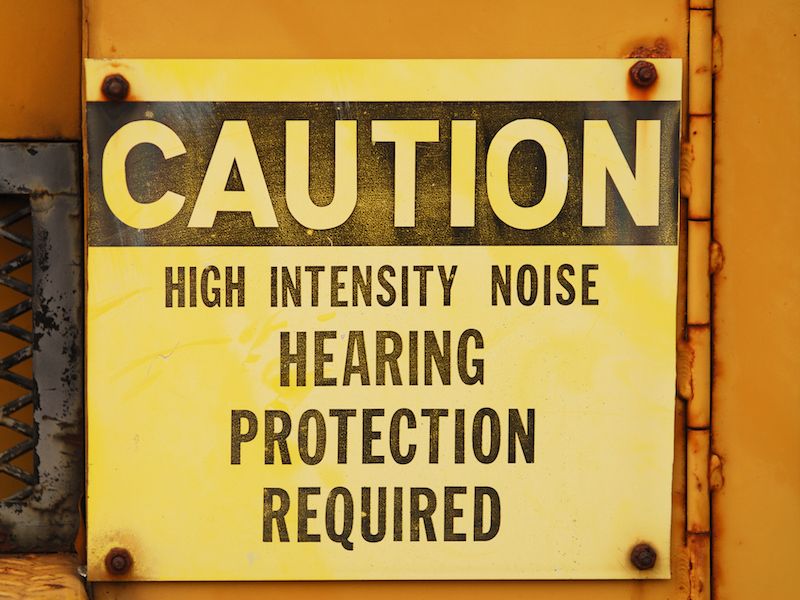
Realizing you should safeguard your hearing is one thing. It’s another matter to know when to protect your ears. It’s not as straight forward as, for example, determining when to use sunblock. (Is the sun out and are you going to be outside? Then you need sunblock.) Even knowing when you need eye protection is simpler (Doing some hammering? Working with a saw or dangerous chemicals? Wear eye protection).
With regards to when to wear hearing protection, there seems to be a huge grey area which can be risky. Usually, we’ll defer to our natural inclination to avoid hearing protection unless we’re given information that a specified activity or place is dangerous.
A Tale of Risk Analysis
In general, we’re not very good at assessing risk, especially when it comes to something as intangible as permanent hearing damage or loss of hearing. Here are some examples to demonstrate the situation:
- A very loud rock concert is attended by person A. 3 hours is approximately how long the concert lasts.
- A landscaping company is run by person B. She spends a significant amount of time mowing lawns, then goes home to a quiet house and reads a book.
- Person C is an office worker.
You may believe the hearing hazard is greater for person A (let’s just call her Ann). For most of the next day, her ears will still be screeching from the loud concert. Presuming Ann’s activity was hazardous to her hearing would be reasonable.
The noise that person B (let’s just call her Betty), is subjected to is not as loud. Her ears don’t ring. So it must be less hazardous for her hearing, right? Well, not really. Because Betty is pushing that mower all day. Actually, the damage accumulates a little at a time although they don’t ring out. Even moderate noises, if experienced with enough frequency, can damage your ears.
Person C (let’s call her Chris) is even less obvious. Lawnmowers come with instructions that indicate the risks of long-term exposure to noise. But while Chris works in a quiet office, she has a really noisy, hour-long commute each day on the train. What’s more, she sits at her desk and listens to music through earbuds. Does she need to give some thought to protection?
When You Should Think About Safeguarding Your Hearing
The standard guideline is that if you need to raise your voice to be heard, your surroundings are noisy enough to do harm to your hearing. And if your surroundings are that noisy, you need to think about using earmuffs or earplugs.
So to put this a little more clinically, you should use 85dB as your cutoff. Noises above 85dB have the capacity to result in damage over time, so you need to consider wearing ear protection in those circumstances.
Your ears don’t have a built-in decibel meter to warn you when you get to that 85dB level, so many hearing professionals recommend downloading specialized apps for your phone. These apps can show you when the surrounding sound is approaching a dangerous level, and you can take suitable steps.
A Few Examples
Your phone may not be with you wherever you go even if you do get the app. So a few examples of when to protect your ears might help you establish a good baseline. Here we go:
- Exercise: Your morning spin class is a good example. Or perhaps your daily elliptical session. All of these cases could call for ear protection. Those trainers who make use of microphones and sound systems (and loud music) to motivate you might be good for your heart rate, but all that loudness is bad for your hearing.
- Listening to music with earbuds. This one requires caution, not protection. Whether your music is going directly into your ears, how loud it is playing, and how long you’re listening to it are all things you should give consideration to. Noise-canceling headphones are a good choice to avoid having to turn the volume way up.
- Residential Chores: We already discussed how something as basic as mowing the lawn, when done often enough, can call for hearing protection. Cutting the grass is a great example of the sort of household task that might cause injury to your hearing but that you most likely won’t think about all that often.
- Driving & Commuting: Driving all day as an Uber or Lyft driver? Or maybe you’re riding a subway after waiting for a little while downtown. The noise of living in a city is bad enough for your ears, not to mention the extra injury caused by cranking up your music to drown out the city noise.
- Working With Power Tools: You know you will need hearing protection if you work every day in a factory. But how about the hobbyist building in his garage? Most hearing specialists will suggest you wear hearing protection when working with power tools, even if it’s just on a hobbyist basis.
These illustrations might give you a suitable baseline. If there is any doubt, though, wear protection. In the majority of cases, it’s better to over-protect your hearing than to leave them exposed to possible injury in the future. Protect today, hear tomorrow.
